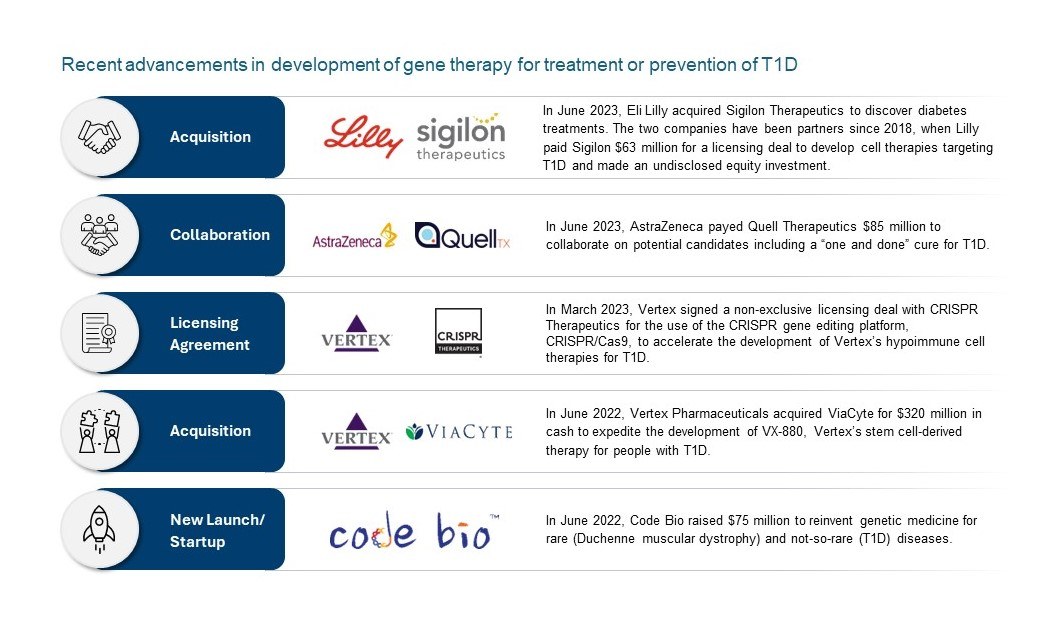Gene Therapy: Revolutionizing Type 1 Diabetes Care
Published on 19 Apr, 2024

Type 1 diabetes results from intricate interactions between genetic predisposition and environmental triggers. Existing treatments often fall short of providing sustained relief, prompting the search for alternative solutions. Gene therapy offers such avenues by either reprogramming alpha cells to perform beta cell function or providing gene editing tools that cut out damaged DNA altogether. The landscape of cell and gene therapy is ever evolving, accelerated by substantial investments, novel technology, and strategic partnerships among key major players. Cutting-edge technology, regulatory backing, and favorable market conditions are propelling alternative therapies towards mainstream acceptance.
Type 1 diabetes (T1D) is a multifaceted interplay of genetic predisposition and environmental triggers, resulting in an autoimmune response that targets and destroys insulin-producing beta cells in the pancreas. As beta cells are destroyed, the production of insulin diminishes, leading to impaired glucose regulation. The absence of sufficient insulin results in elevated blood glucose levels, contributing to the hallmark symptoms of diabetes, such as increased thirst, frequent urination, and unexplained weight loss. The impaired ability of beta cells to regenerate is a critical aspect of T1D. Even when environmental triggers initiate the autoimmune response, understanding the genetic factors influencing beta cell dysfunction provides insights into potential therapeutic interventions. We discussed the etiology of T1D, genetic predisposition and participating events here.
Current standard treatment options include Pancreas or beta cell transplant, and maintenance therapy which requires patients monitor blood glucose throughout the day to estimate the amount of insulin needed to prevent hyperglycemia (high blood sugar) without causing hypoglycemia (low blood sugar). Pancreas or beta cells transplant from human donors is a long-term solution but comes with a significant supply problem making only about 1,000 transplants feasible in the US annually. There are several other prophylactic and therapeutic avenues being explored for T1D.
We delve deeper into the current state and future prospects of gene therapy in the context of T1D here.
Gene Therapy
Gene therapy involves modifying diseased cells by replacing, inactivating damaged genes, or introducing new or modified genes to treat or potentially cure them. In a 2018 study, scientists reprogrammed alpha cells in the pancreas to function similarly to beta cells. They engineered an adeno-associated vector (AAV) to deliver two proteins, pancreatic and duodenal homeobox 1 and MAF basic leucine zipper transcription factor A, to a mouse’s pancreas. These proteins facilitated beta cell proliferation, maturation, and function, resulting in normalized blood sugar levels in the mouse for four months without requiring immunosuppressant drugs. The engineered alpha cells mimicked beta cells and were resistant to immune attacks. However, such gene therapy treatments would likely not offer a one-time cure.
A potential “one and done” therapy could be gene editing in which the body’s DNA is reprogrammed. The focus of gene editing is to cut out the damaged part of the DNA to avoid the disease altogether. In the case of T1D, this looks like getting at the underlying reason for the auto-immune attack on the beta cells that cause diabetes to begin with.
Key Advancements
In June 2022, CRISPR Therapeutics and ViaCyte collaborated to administer the first patient dose in a Phase I clinical trial of innovative gene-edited cell replacement therapy. Through the integration of CRISPR Therapeutics gene-editing technology and ViaCyte’s proprietary pluripotent stem cell line, they developed VCTX210. This treatment produces pancreatic cells designed to evade immune system detection, thus safeguarding them from attack. The differentiated cells generate glucose-responsive insulin-secreting cells within the patient.
Another notable startup, Sigilon Therapeutics, is developing Shielded Living Therapeutics™ (SLTx) for diabetes, which entails encapsulating insulin-producing cells within a semi-permeable barrier, shielding them from immune system attacks while permitting essential nutrients to pass through.
In October 2022, the Australian government greenlit the Targeted Translation Research Accelerator program for diabetes and cardiovascular disease. This trial, a first of its kind for T1D gene therapy, focuses on utilizing the protein A20 in genetic engineering to protect insulin-producing islet cells from immune damage.
The following table captures pivotal moments where companies have joined forces, acquired assets, or engaged in collaborative efforts to advance innovative treatments:

Regulatory
On the regulatory front, both the FDA and European Medicines Agency (EMA), recognizing the transformative potential of these therapies, have streamlined pathways to expedite their development and approval. The FDA has granted several expedited pathways to companies, including breakthrough therapy, fast track, and regenerative medicine advanced therapy designations, to accelerate the development of cell and gene therapies for T1D. Noteworthy examples include the approval of CellTrans' Lantidra, which is the first cellular therapy to treat T1D.
The landmark approval of Vertex's CRISPR-based drug, moving closer to fruition after successful trial outcomes, highlights FDA's commitment to advancing transformative therapies, signaling a new era in regulatory support for innovative treatments in the domain of T1D.
Furthermore, EMA has implemented strategies to facilitate the translation of scientific advancements into safe and effective therapies. The adaptive pathways approach, adopted by the EMA, aims to expedite the delivery of promising therapies to patients by allowing iterative development with real-world evidence collection.
Challenges
Despite significant advancements in the technology, the field of cell and gene therapy faces several challenges:
- One of the initial hurdles lies in the complexity of the immune response, as attempts to modulate, or replace beta cells often encounter resistance.
- Ensuring the long-term safety and efficacy of gene therapies is challenging, necessitating comprehensive monitoring and assessment over extended periods.
- Technical challenges related to efficient gene delivery, precise editing, and scalability in manufacturing also persist, impacting the widespread applicability of these therapies.
- Inflated costs pose a barrier to adoption, not only in terms of the high investment required for the development of such treatments but also the subsequent financial burden on healthcare systems, potentially limiting patient accessibility.
- Ethical considerations must be carefully weighed, particularly regarding the use of embryogenic stem cells in treatment therapies, as their derivation from human embryos may conflict with certain religious views.
Future Prospect
The landscape of cell and gene therapy for Type 1 diabetes is continuously evolving, accelerated by significant investments, novel technology, and strategic partnerships among major players. Advances in delivery methods and gene editing techniques such as enhancing specificity and survivability of regulatory T cells to suppress autoimmune responses and restore immune balance, show promise for a more targeted treatment of T1D. The convergence of cutting-edge technology, regulatory support, and favorable market conditions synergistically drives gene therapy beyond its origins in rare diseases toward broader mainstream acceptance.

